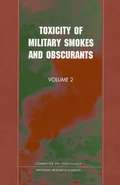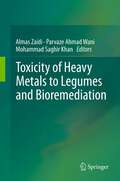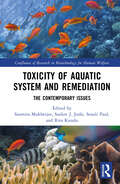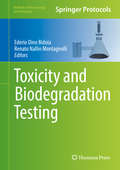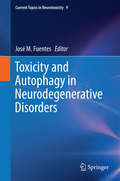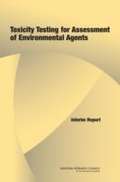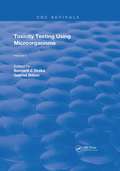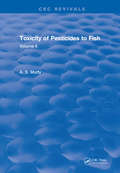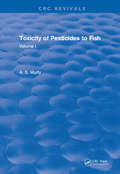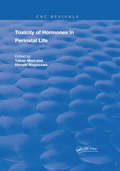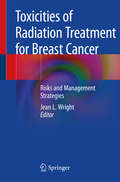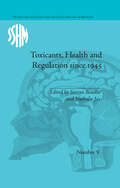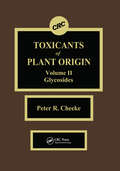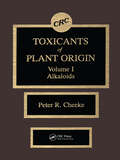- Table View
- List View
Toxicity-Pathway-Based Risk Assessment: Preparing for Paradigm Change - A Symposium Summary
by National Research Council of the National AcademiesIn 2007, the National Research Council envisioned a new paradigm in which biologically important perturbations in key toxicity pathways would be evaluated with new methods in molecular biology, bioinformatics, computational toxicology, and a comprehensive array of in vitro tests based primarily on human biology. Although some considered the vision too optimistic with respect to the promise of the new science, no one can deny that a revolution in toxicity testing is under way. New approaches are being developed, and data are being generated. As a result, the U.S. Environmental Protection Agency (EPA) expects a large influx of data that will need to be evaluated. EPA also is faced with tens of thousands of chemicals on which toxicity information is incomplete and emerging chemicals and substances that will need risk assessment and possible regulation. Therefore, the agency asked the National Research Council to convene a symposium to stimulate discussion on the application of the new approaches and data in risk assessment. The symposium was held on May 11-13, 2009, in Washington, DC, and included presentations and discussion sessions on pathway-based approaches for hazard identification, applications of new approaches to mode-of-action analyses, the challenges to and opportunities for risk assessment in the changing paradigm, and future directions.
Toxicity of Nanomaterials: Environmental and Healthcare Applications
by Suresh C. Pillai Yvonne LangThis comprehensive book, edited by two leading experts in nanotechnology and bioengineering with contributions from a global team of specialists, provides a detailed overview of the environmental and health impacts associated with the toxicology of nanomaterials. Special attention is given to nanomaterial toxicity during synthesis, production and application, and chapters throughout are focused on key areas that are important for future research and development of nanomaterials. This book will be of interest to advanced students studying biomedical engineering and materials science, PhD researchers, post-docs and academics working in the area of nanotechnology, medicine, manufacturing and regulatory bodies. Features: Collates and critically evaluates various aspects of the toxicology of nanomaterials in one comprehensive text Discusses the various effects of nanocrystals including the morphologies on cytotoxicity, in addition to the environmental and cytotoxicity risks of graphene and 2D nanomaterials Explores practical methods of detection and quantification, with applications in the environmental and healthcare fields
Toxicity of Military Smokes and Obscurants: Volume 3
by National Research CouncilThe National Academies Press (NAP)--publisher for the National Academies--publishes more than 200 books a year offering the most authoritative views, definitive information, and groundbreaking recommendations on a wide range of topics in science, engineering, and health. Our books are unique in that they are authored by the nation's leading experts in every scientific field.
Toxicity of Military Smokes and Obscurants: Volume 2
by Commttee on Toxicology National Research CouncilThe National Academies Press (NAP)--publisher for the National Academies--publishes more than 200 books a year offering the most authoritative views, definitive information, and groundbreaking recommendations on a wide range of topics in science, engineering, and health. Our books are unique in that they are authored by the nation's leading experts in every scientific field.
Toxicity of Heavy Metals to Legumes and Bioremediation
by Almas Zaidi Mohammad Saghir Khan Parvaze Ahmad WaniThis title discusses various effects of heavy metal exposure to legumes as well as the bioremediation potential of rhizosphere microbes. Availability of heavy metals, their uptake and the effects of metals on various signaling pathways within legumes are presented. Furthermore, the effects of heavy metals to nitrogen fixing microorganisms and how microsymbionts can overcome metal stress is presented in detail. The role of nitrogen fixers in decontamination of heavy metal toxicity, mycoremediation of metal contaminated soils, microbially mediated transformation of heavy metals and action of plant growth promoting rhizobacteria and nitrogen fixers together in detoxifying heavy metals are broadly explained. This volume is a useful tool for scientists, policy makers and progressive legume growers intending to develop safe and healthy legumes for future generations.
Toxicity of Aquatic System and Remediation: The Contemporary Issues (Confluence of Research in Biotechnology for Human Welfare)
by Rita Kundu Susmita Mukherjee Sanket J. Joshi Sonali PaulThe eco-friendly remediation technologies for the degraded environment are indeed the “need of the hour”. Even though the regulatory mechanisms are in place to control the discharge of untreated contaminants into the natural environment, still, we could see a different picture; hence, remediation and restoration of the environment becomes an ardent requisite. The present-day fast pace of industrialization without proper disposal planning is impacting the water bodies adversely, generating the need for green management technologies. It is worth mentioning that these environment-friendly technologies are most cost-effective as well. The advancements in biotechnology have paved the way to mitigate the problem.The primary audience of this book are the students and researchers who are working in the field of toxicology and bioremediation of aquatic environments. We have primarily focused in this book on bioremediation of aquatic system toxicity, considering this as an environment-friendly system and having the least adverse effects. Hence this book aims to bring forward together on a single platform the latest research in aquatic resource management, which includes the discussions and discourses on the degradation and the effect and the remediation.This book includes a discussion on the different sources of contamination from industries or by the usage of commercial pesticides or even fertilizers. These contaminants, if discharged in their toxic form as effluent, cause harm to the aquatic systems and the subsoil and create the possibility of groundwater contamination. This book includes a discussion on the different routes of contamination and the food-chain transport possibilities of pesticide pollutants, which are very contemporary and required topics of research. It also includes relevant discussions on how to get rid of the toxicity.
Toxicity in the Workplace: Coping with Difficult People on the Job
by Shonda Lackey PhDNavigating a toxic work environment—a guide to managing difficult colleagues and stressful situations There are everyday challenging work relationships, and then there are situations that go beyond the ordinary—situations that push you to the edge. Written by a clinical psychologist who is knowledgeable about the mental disorders that can cause toxic behavior, Toxicity in the Workplace will help you understand why your difficult colleagues act the way they do and gain practical strategies for negotiating more peaceful, productive solutions. Armed with new insight into your colleagues' behaviors, you will learn pragmatic techniques that will give you the confidence to advocate for yourself and, when needed, remove yourself from uncomfortable situations and conversations. This book about dealing with toxic behavior in the workplace includes: Techniques for everyone—Learn approaches for communication with toxic people at all levels within an organization that are tailored to various problematic behaviors. Understand deeper motivations—Common anxiety, mood, and personality disorders are explained. Learn by example—Vivid case studies illustrate familiar scenes at work and model how you can respond respectfully and assertively. When you're looking for a book about how best to deal with difficult people at work, look no further than Toxicity in the Workplace.
Toxicity and Risk: Context, Principles and Practice
by H Paul IllingThis book aims to set out the political, social, legal and scientific underpinning of risk assessment and risk management for toxic substances. It describes the principles and processes the practitioners undertake when looking at the regulatory risk implications of their work.
Toxicity and Metabolism of Explosives
by Jehuda YinonThe purpose of this important monograph is to provide the reader with a better understanding of the toxicity, channels of absorption, and metabolism of explosives by the body. This one-of-a-kind work also incorporates the symptoms and clinical manifestations of poisoning by these compounds. It discusses how the disposal of explosives and their degr
Toxicity and Biodegradation Testing
by Ederio Dino Bidoia Renato Nallin MontagnolliThis volume presents a broad compendium of techniques used in biodegradation and toxicological research. Through both legacy and up-to-date approaches to practical methodologies with proven results, the book examines the role and applications of analytical biodegradation quantification as it applies to the environmental sciences, particularly in the range of byproducts that are usually linked to toxicology, and the test organisms most often used in toxicity testing. Topics include scientific and technical feasibility studies, contaminant impacts evaluation, study design and analytical techniques, key methodologies required to prepare the biodegradation and toxicology protocols, as well as the handling of microbial communities related to such processes. Written for the Methods in Pharmacology and Toxicology series, chapters deal with a critical discussion of laboratory scale experiments, as well as full scale in situ and ex situ apparatus, with each chapter containing both a discursive section along with a detailed methods section. Detailed and authoritative, Toxicity and Biodegradation Testing is primarily focused toward the environmental sciences researcher, while the range of techniques also provides an introduction to biodegradation and toxicology methods for researchers outside of the field.
Toxicity and Autophagy in Neurodegenerative Disorders
by José M. FuentesComprehensive overview of different aspects of autophagy as it relates to neurodegenerative diseases. The pathogenesis of the main neurodegenerative disorders includes either the accumulation of altered or misfolded proteins or exposure to several toxics. Autophagy constitute one of the two principal cellular pathways implicate in the clearance of these material and can serve as a neuroprotective mechanism. Topics include: the role of autophagy in the brain, the role of autophagy in the principal neurodegenerative disorders, and the mechanism by which different molecules cause neurotoxicity and the role autophagy plays.
Toxicity Testing in the 21st Century: A Vision and a Strategy
by National Research Council of the National AcademiesOnce dismissed by the medical profession as a purely cosmetic problem, obesity now ranks second only to smoking as a wholly preventable cause of death. Indeed, it's implicated in 300,000 deaths each year and is a major contributor to heart disease, diabetes, high blood pressure, high cholesterol, and depression. Even conservative estimates show that 15% of all children are now considered to be overweight--worldwide there are 22 million kids under five years old that are defined as fat. Supersized portions, unhealthy diets, and too little physical activity certainly contribute to what's making kids 'fat'. But that's not the whole story. Researchers are at a loss to explain why obesity rates have risen so suddenly and so steeply in the closing decades of the 20th century. But head out to the beaches, playgrounds, and amusement parks, and it's obvious that overweight children are more numerous and conspicuous. We see it in our neighborhoods and we read it in the headlines. Our nation--indeed the world--is in crisis. But knowledge is power and it's time to arm ourselves in the battle to win the war on obesity. Fed Up! is just what the doctor ordered. Based in part on the Institute of Medicine's ground-breaking report on childhood obesity, this new book from family physician and journalist Susan Okie provides in-depth background on the issue; shares heartrending but instructive case studies that illustrate just how serious and widespread the problem is; and gives honest, authoritative, science-based advice that constitute our best weapons in this critical battle.
Toxicity Testing for Assessment of Environmental Agents: Interim Report
by National Research Council of the National AcademiesToxicity testing in laboratory animals provides much of the information used by the Environmental Protection Agency (EPA) to assess the hazards and risks associated with exposure to environmental agents that might harm public health or the environment. The data are used to establish maximum acceptable concentrations of environmental agents in drinking water, set permissible limits of exposure of workers, define labeling requirements, establish tolerances for pesticides residues on food, and set other kinds of limits on the basis of risk assessment. Because the number of regulations that require toxicity testing is growing, EPA called for a comprehensive review of established and emerging toxicity-testing methods and strategies. This interim report reviews current toxicity-testing methods and strategies and near-term improvements in toxicity-testing approaches proposed by EPA and others. It identifies several recurring themes and questions in the various reports reviewed. The final report will present a long-range vision and strategic plan to advance the practices of toxicity testing and human health assessment of environmental contaminants.
Toxicity Testing Using Microorganisms (Routledge Revivals #2)
by Gabriel Bitton Bernard J. DutkaFirst Published in 1986, this two-volume set offers comprehensive insight into the testing of toxic substances using microorganisms as reference. Carefully compiled and filled with a vast repertoire of notes, diagrams, and references this book serves as a useful reference for students of medicine and other practitioners in their respective fields.
Toxicity Testing Using Microorganisms (Routledge Revivals #1)
by Gabriel Bitton Bermard J. DutkaFirst Published in 1986, this two-volume set offers comprehensive insight into the testing of toxic substances using microorganisms as reference. Carefully compiled and filled with a vast repertoire of notes, diagrams, and references this book serves as a useful reference for students of medicine and other practitioners in their respective fields.
Toxicity Of Pure Foods (Routledge Revivals)
by E. M. BoydFirst Published in 1973, this book offers a full, comprehensive guide into the toxicology of certain foods. Carefully compiled and filled with a vast repertoire of notes, diagrams, and references this book serves as a useful reference for students of toxicology, and other practitioners in their respective fields.
Toxicity Of Pesticides To Fish: Volume II
by MurtyThe present work is the first major attempt at reviewing comprehensively all the available information about the environmental fate and behaviour of the xenobiotic chemicals.
Toxicity Of Pesticides To Fish: Volume I
by A.S. MurtyThe present work is the first major attempt at reviewing comprehensively all the available information about the environmental fate and behaviour of the xenobiotic chemicals.
Toxicity Of Hormones In Perinatal Life (Routledge Revivals)
by Takao Mori Hiroshi NagasawaFirst Published in 1988, this book offers a full, comprehensive guide into the toxicity of hormones during childbirth. Carefully compiled and filled with a vast repertoire of notes, diagrams, and references this book serves as a useful reference for students of midwifery, and other practitioners in their respective fields.
Toxicity Assessment: Methods and Protocols (Methods in Molecular Biology #2240)
by Carlos Manuel Marques Palmeira Danielle Palma de Oliveira Daniel Junqueira DortaThis book collects protocols from different areas of knowledge to assist in the identification of toxic effects exerted by different xenobiotics. At the same time as classical techniques are presented, modern techniques with alternative models to the use of animals are also presented. Given the ever-increasing exposure to different compounds and their effects on population health, the assessment of multiple endpoints is of utmost importance for better risk assessment, and this collection addresses that need. Written for the highly successful Methods in Molecular Biology series, chapters include introductions to their respective topics, lists of the necessary materials and reagents, step-by-step, readily reproducible laboratory protocols, and tips on troubleshooting and avoiding known pitfalls. Authoritative and practical, Toxicity Assessment: Methods and Protocols aims to serve researchers in this vast field of science as they seek to better understand the mechanisms of action of different xenobiotics.
Toxicities of Radiation Treatment for Breast Cancer: Risks And Management Strategies
by Jean L. WrightThis book is a comprehensive guide to breast toxicity. Adjuvant radiation remains standard for a majority of women who undergo breast-conserving surgery for breast cancer, and indications for post-mastectomy and regional lymph node irradiation have also broadened with recent publications. At the same time, locoregional recurrence has declined and survival has improved in recent decades. In the current era of excellent breast cancer outcomes, then, considering the balance between toxicity and outcomes becomes paramount. Several recent editorials recommend considering toxicity against the potential benefit of adjuvant radiation in tailoring radiation decisions for individual patients. Thus, a clear understanding of the potential toxicities of adjuvant radiation for breast cancer is critical to optimizing outcomes in modern breast cancer management. Here, authors have collected recent data focused on toxicity of treatment that provide an opportunity for improving this optimization. Chapters cover both acute and late toxicity of radiation for breast cancer, including tailored risk assessment for each of these potential toxicities, considerations for including risk of toxicity in management decisions, and toxicity management strategies. This is an ideal guide for radiation oncologists, residents, and oncologists seeking to optimize care for their patients.
Toxicants, Health and Regulation since 1945 (Studies for the Society for the Social History of Medicine #9)
by Soraya Boudia and Nathalie JasThe number of substances potentially dangerous to our health and environment is constantly increasing. The papers in this volume examine the concurrent rise of pollutants and the regulations designed to police their use.
Toxicants of Plant Origin: Phenolics, Volume IV
by Peter R. CheekeThis comprehensive treatise offers an in-depth discussion of natural toxicants in plants, emphasizing their effects as defenses against herbivory. Coevolution of plants and her-bivores are covered with a detailed treatment of toxicant metabolism and systemic effects in mammalian tissues. Con-sideration of the economic importance of plant toxins, modi-fication by plant breeding, management of toxico-sis, and toxicant problems in various geographic areas are in-cluded. Each volume offers an extensive description of chemistry, biosynthesis, analysis, distribution in plants, metabolism in mam-mals and insects, and practical problems in humans and livestock.
Toxicants of Plant Origin: Glycosides, Volume II
by Peter R. CheekeThis comprehensive treatise offers an in-depth discussion of natural toxicants in plants, emphasizing their effects as defenses against herbivory. Coevolution of plants and her-bivores are covered with a detailed treatment of toxicant metabolism and systemic effects in mammalian tissues. Con-sideration of the economic importance of plant toxins, modi-fication by plant breeding, management of toxico-sis, and toxicant problems in various geographic areas are in-cluded. Each volume offers an extensive description of chemistry, biosynthesis, analysis, distribution in plants, metabolism in mam-mals and insects, and practical problems in humans and livestock.
Toxicants of Plant Origin: Alkaloids, Volume I
by Peter R. CheekeThis comprehensive treatise offers an in-depth discussion of natural toxicants in plants, emphasizing their effects as defenses against herbivory. Coevolution of plants and her-bivores are covered with a detailed treatment of toxicant metabolism and systemic effects in mammalian tissues. Con-sideration of the economic importance of plant toxins, modi-fication by plant breeding, management of toxico-sis, and toxicant problems in various geographic areas are in-cluded. Each volume offers an extensive description of chemistry, biosynthesis, analysis, distribution in plants, metabolism in mam-mals and insects, and practical problems in humans and livestock.



